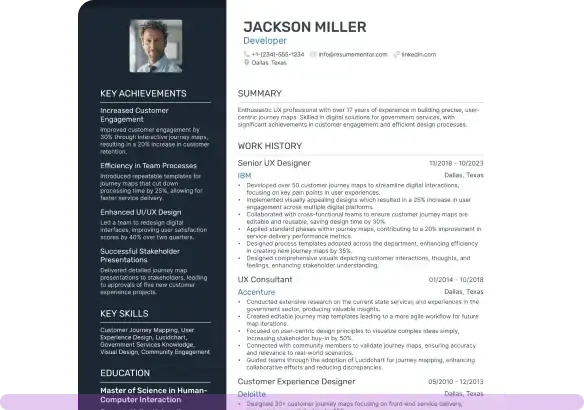Professional Painter Resume Examples

Mar 24, 2025
|
12 min read
Creating a standout painter resume is an art in itself—one brushstroke at a time. Showcase your vibrant skills and talents to catch the eye of employers and paint a bright future in your professional painting career.
Rated by 348 people
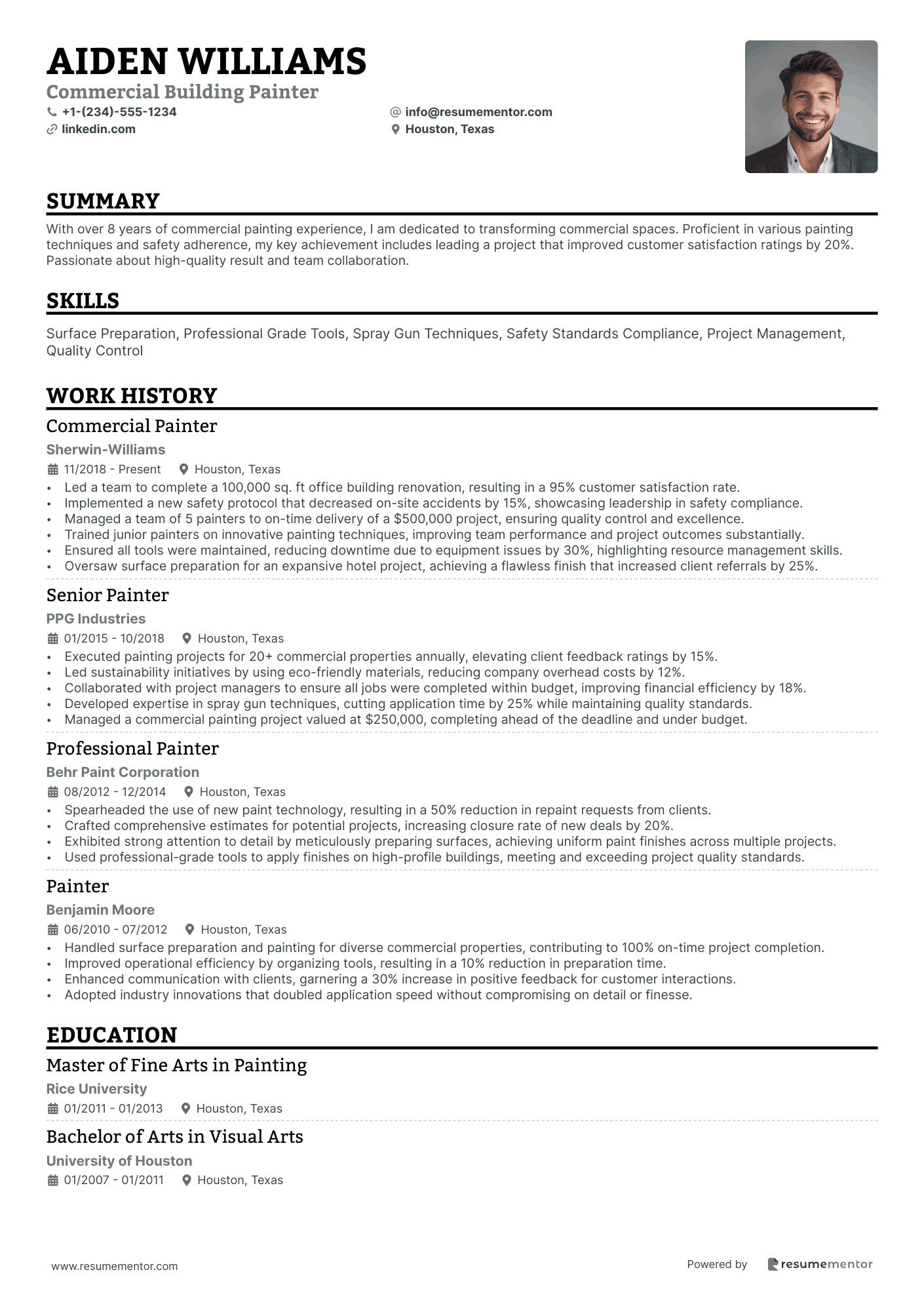
Commercial Building Painter
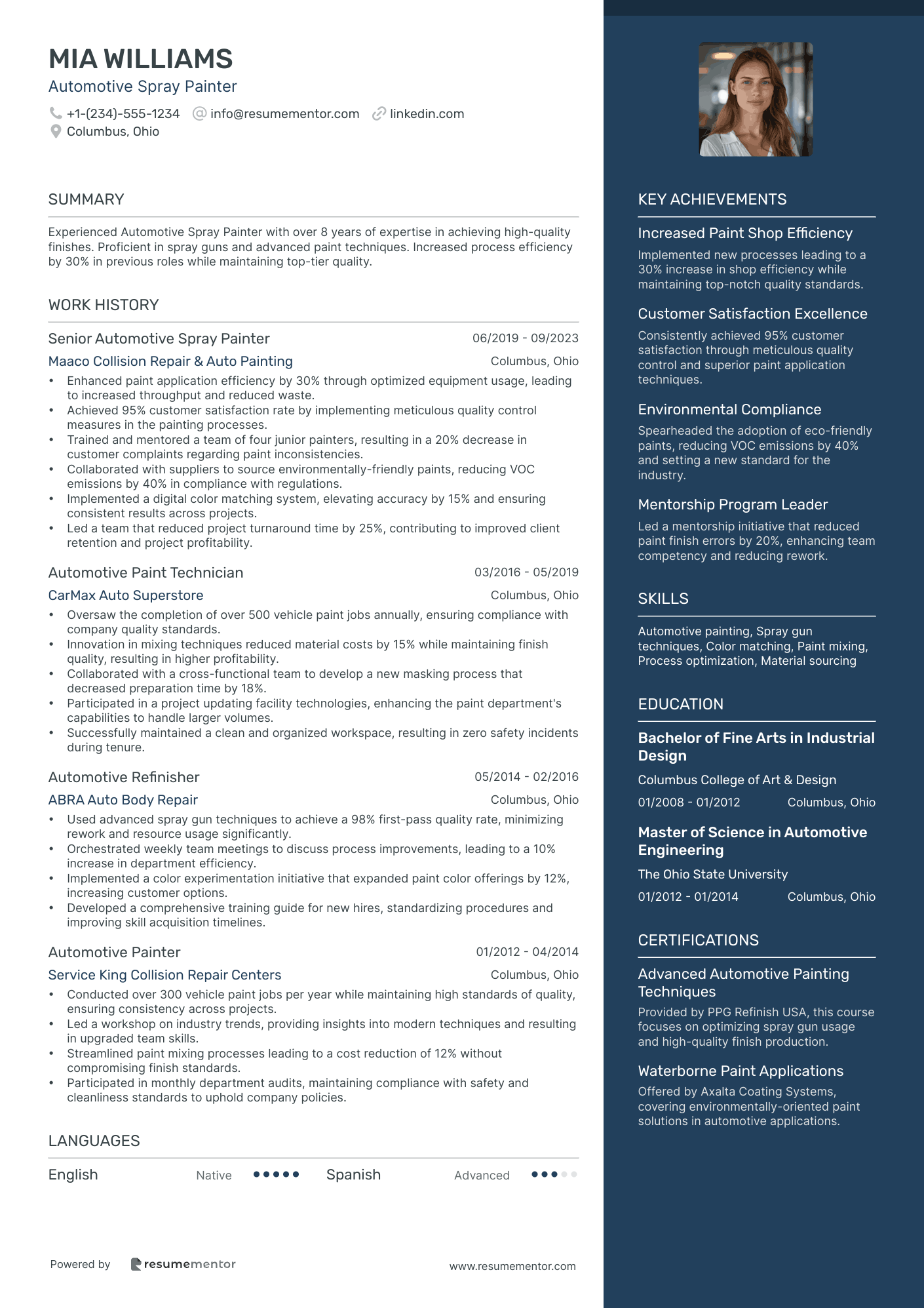
Automotive Spray Painter
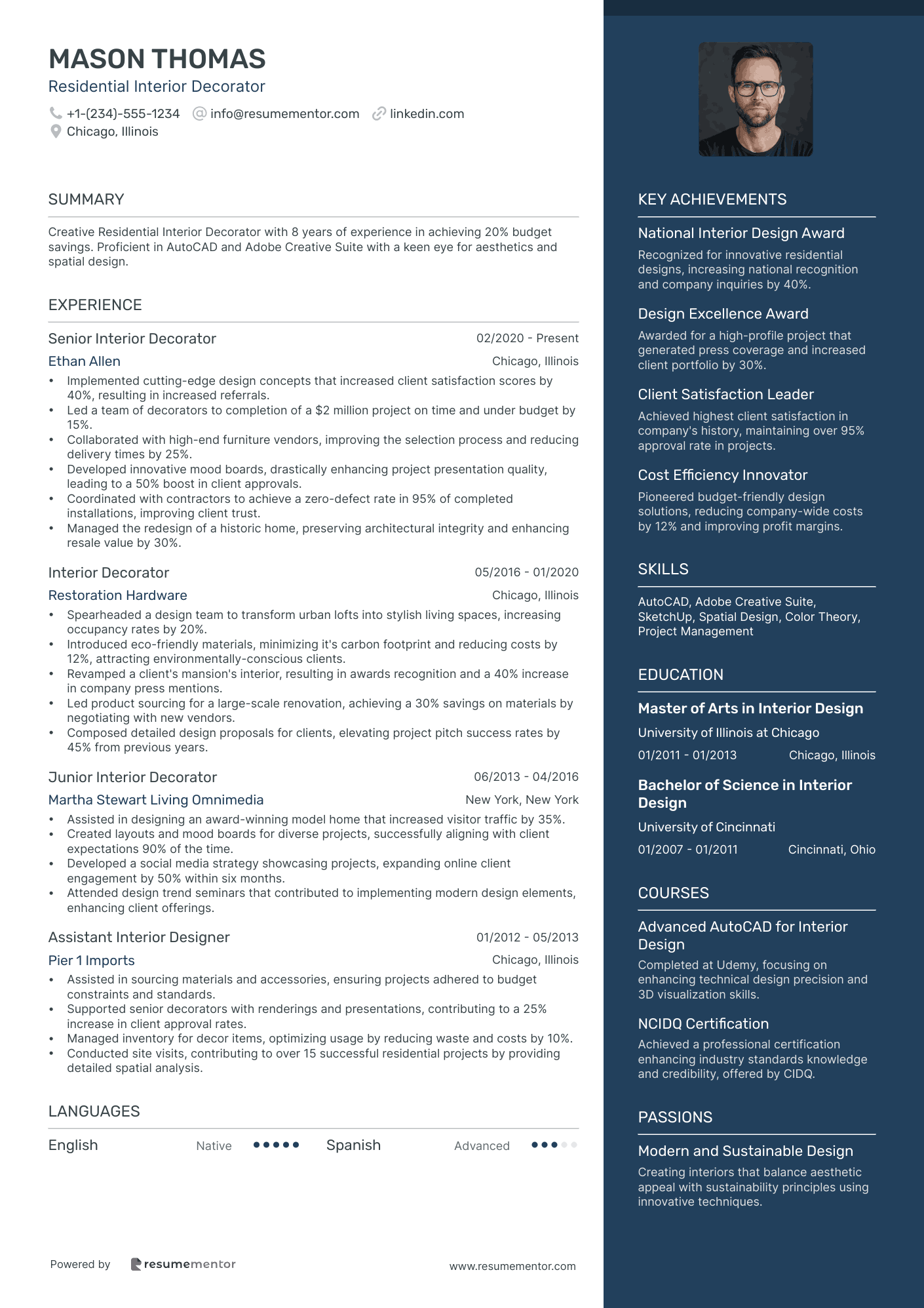
Residential Interior Decorator
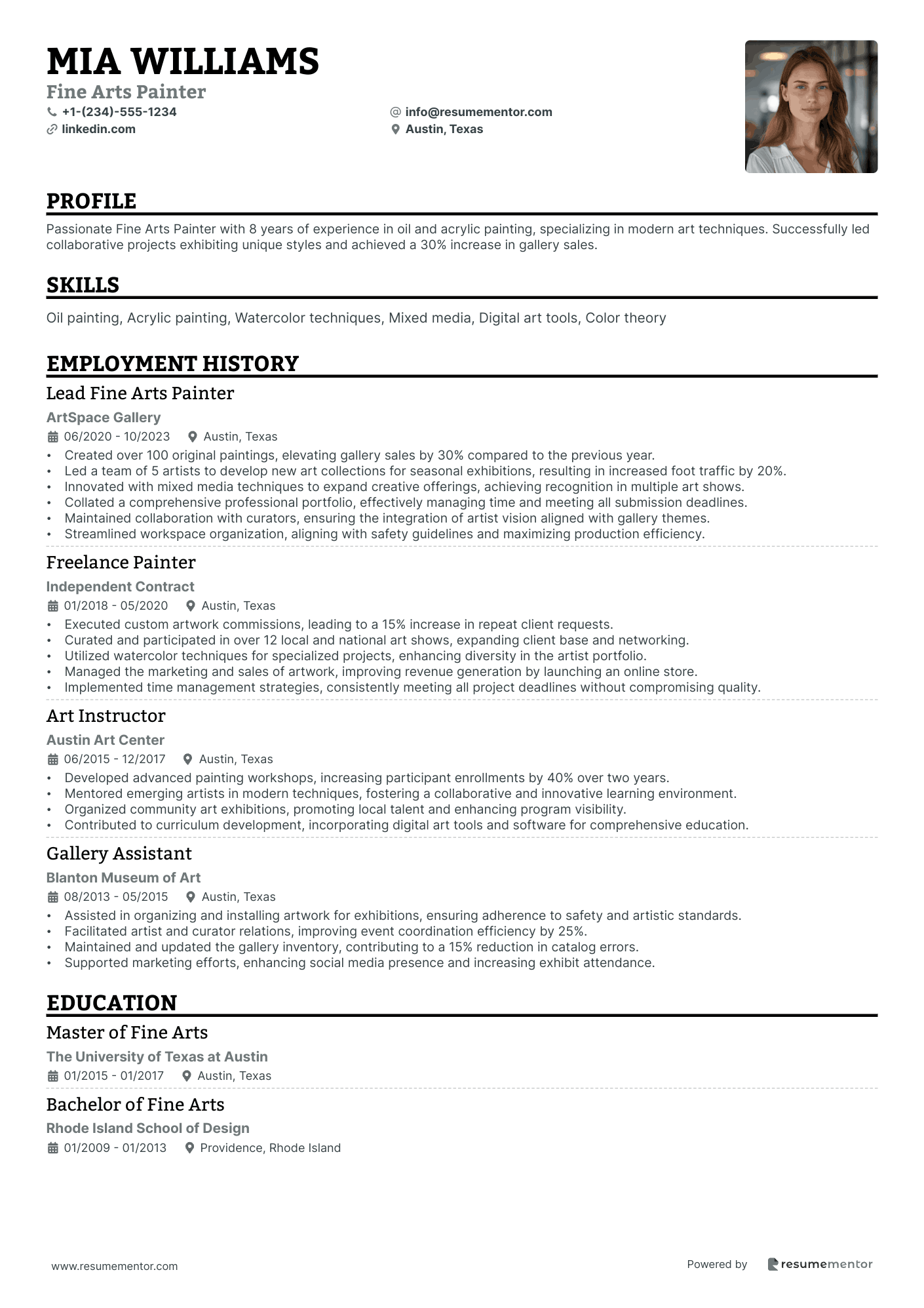
Fine Arts Painter
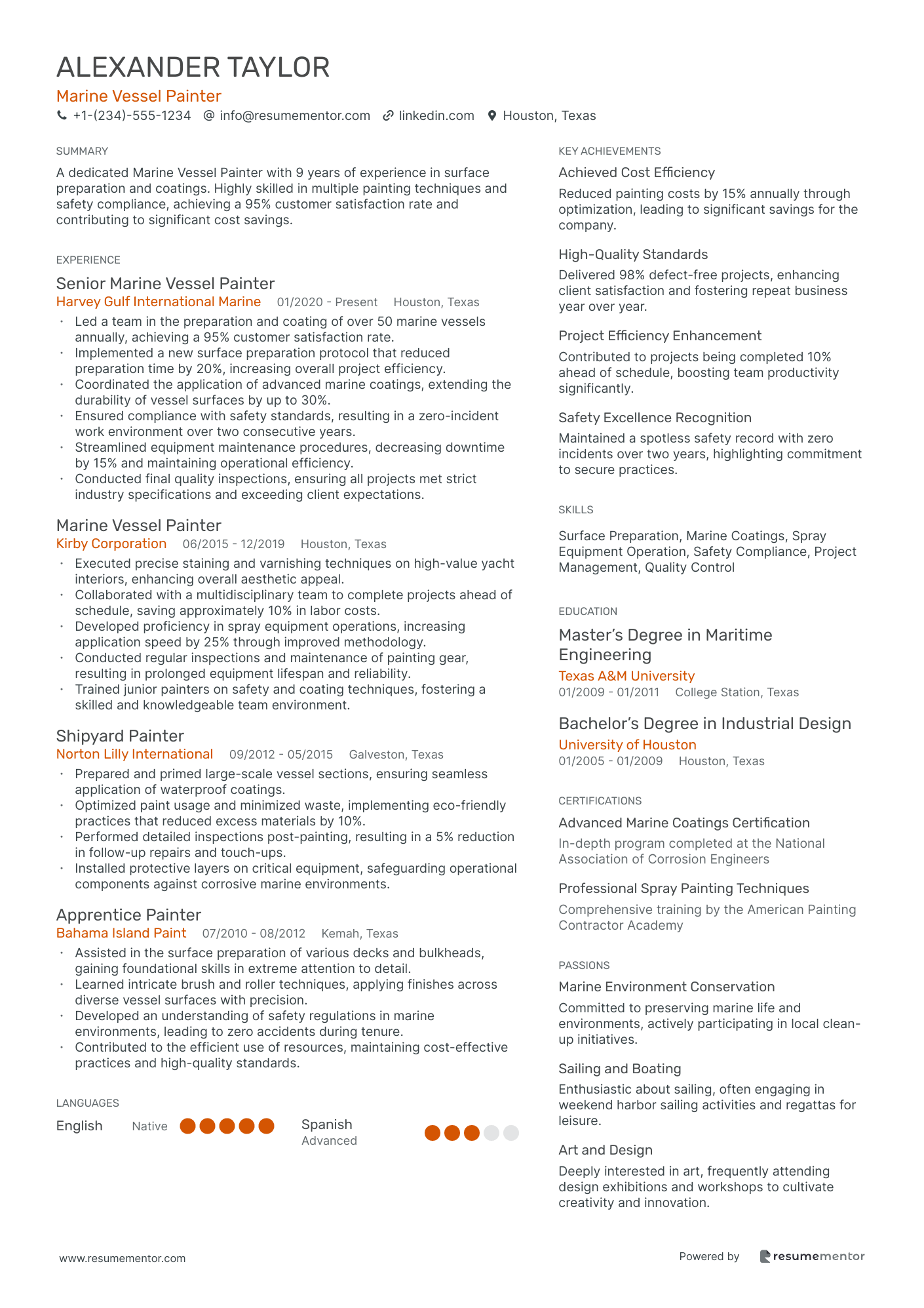
Marine Vessel Painter
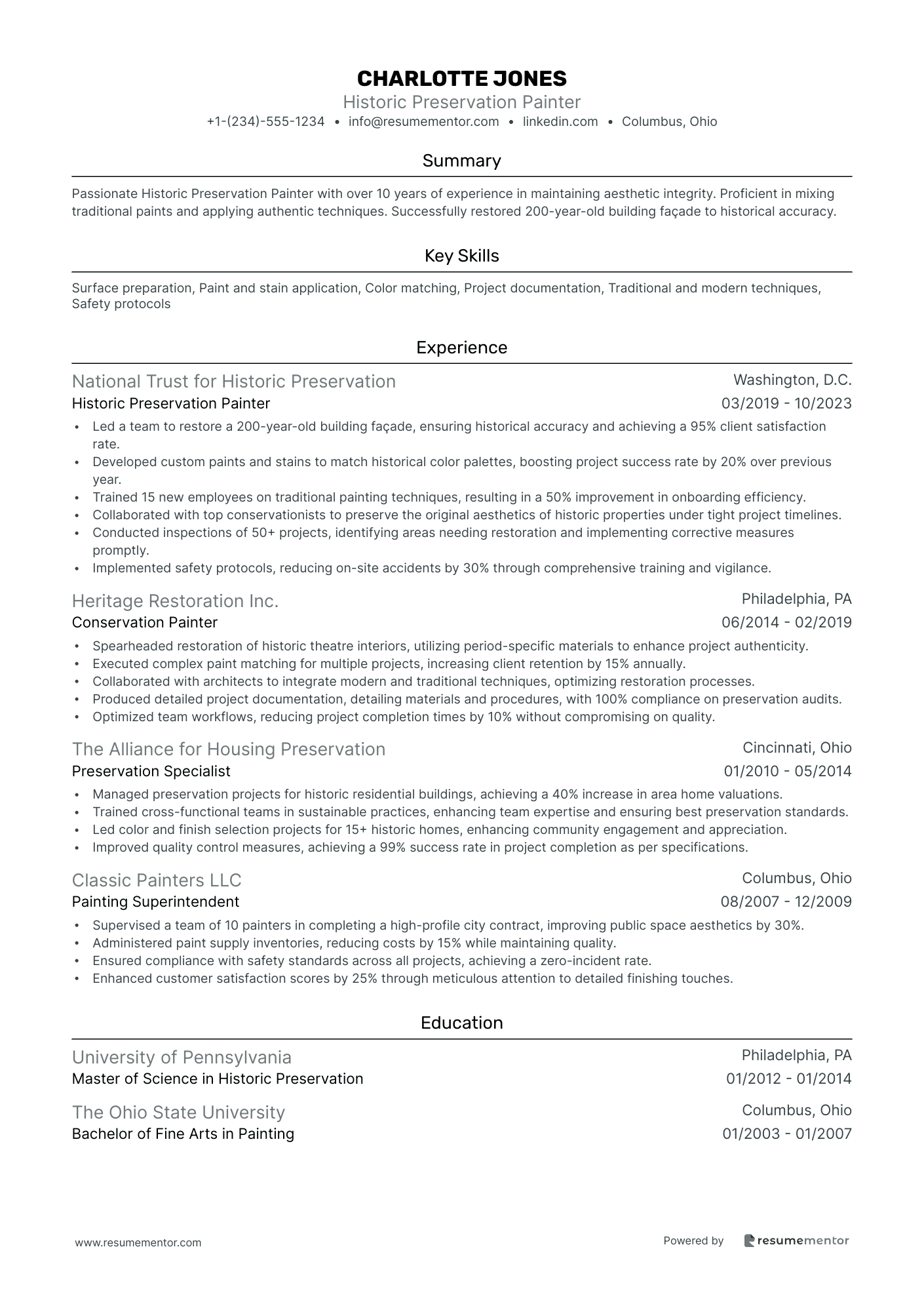
Historic Preservation Painter
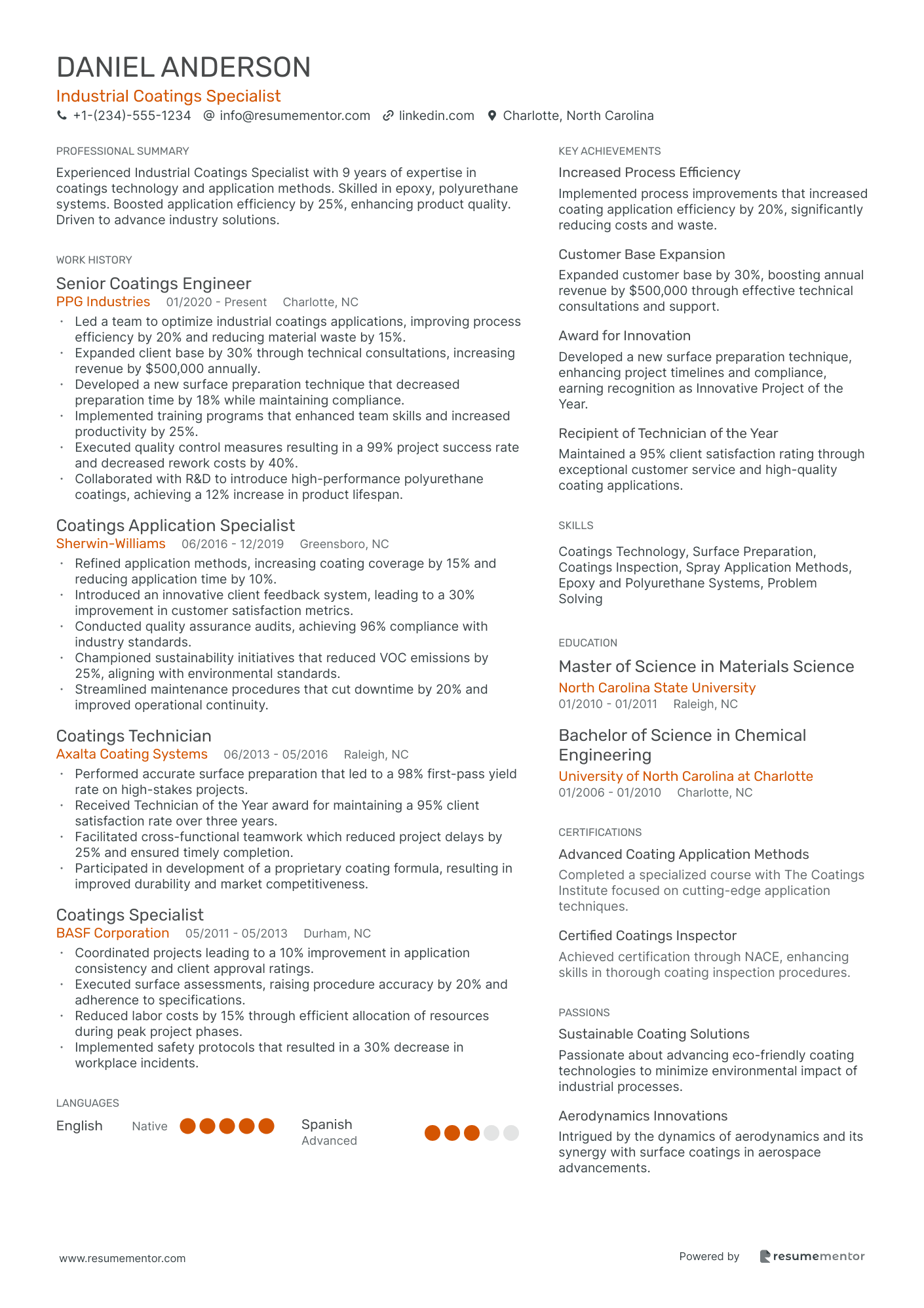
Industrial Coatings Specialist
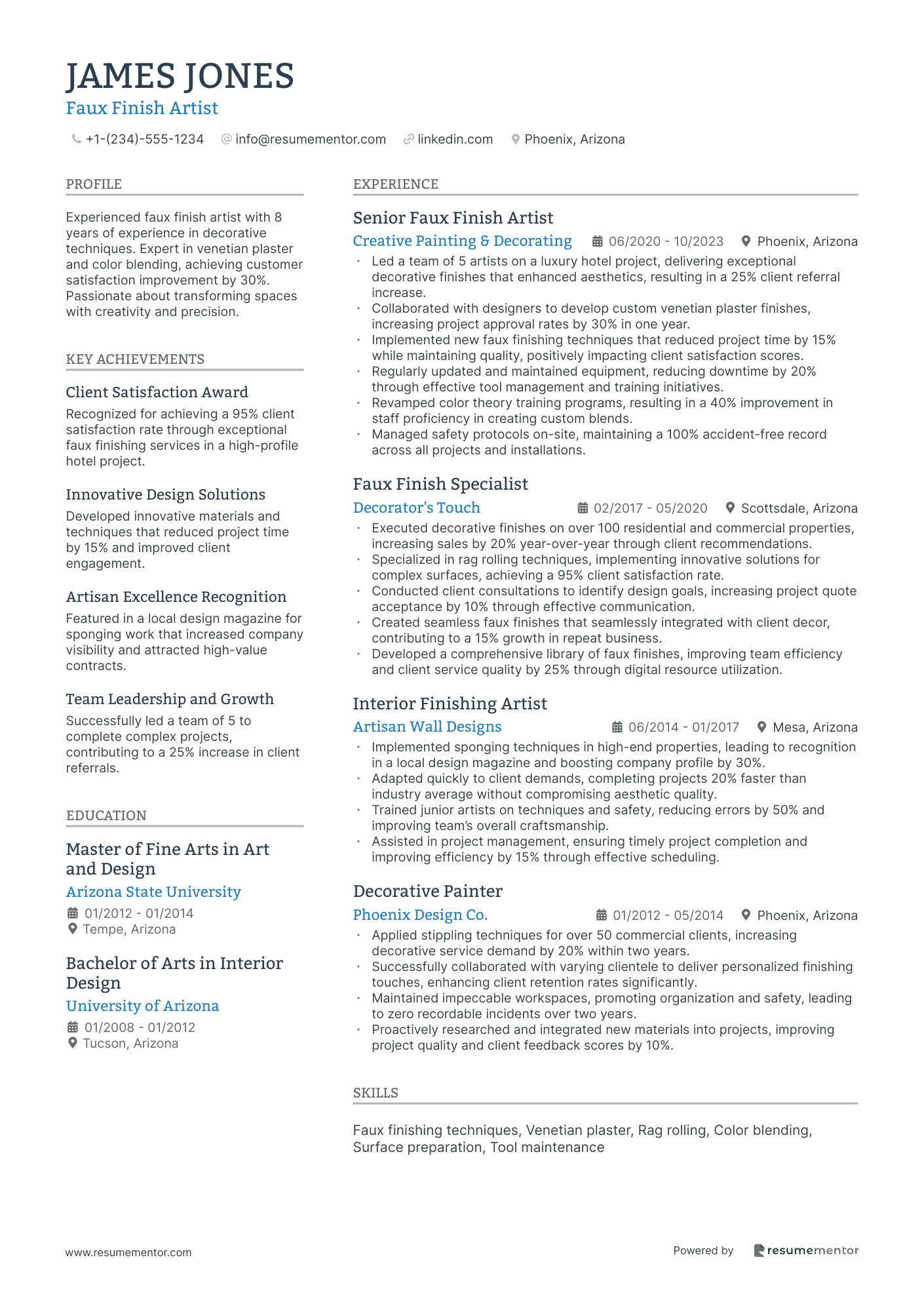
Faux Finish Artist
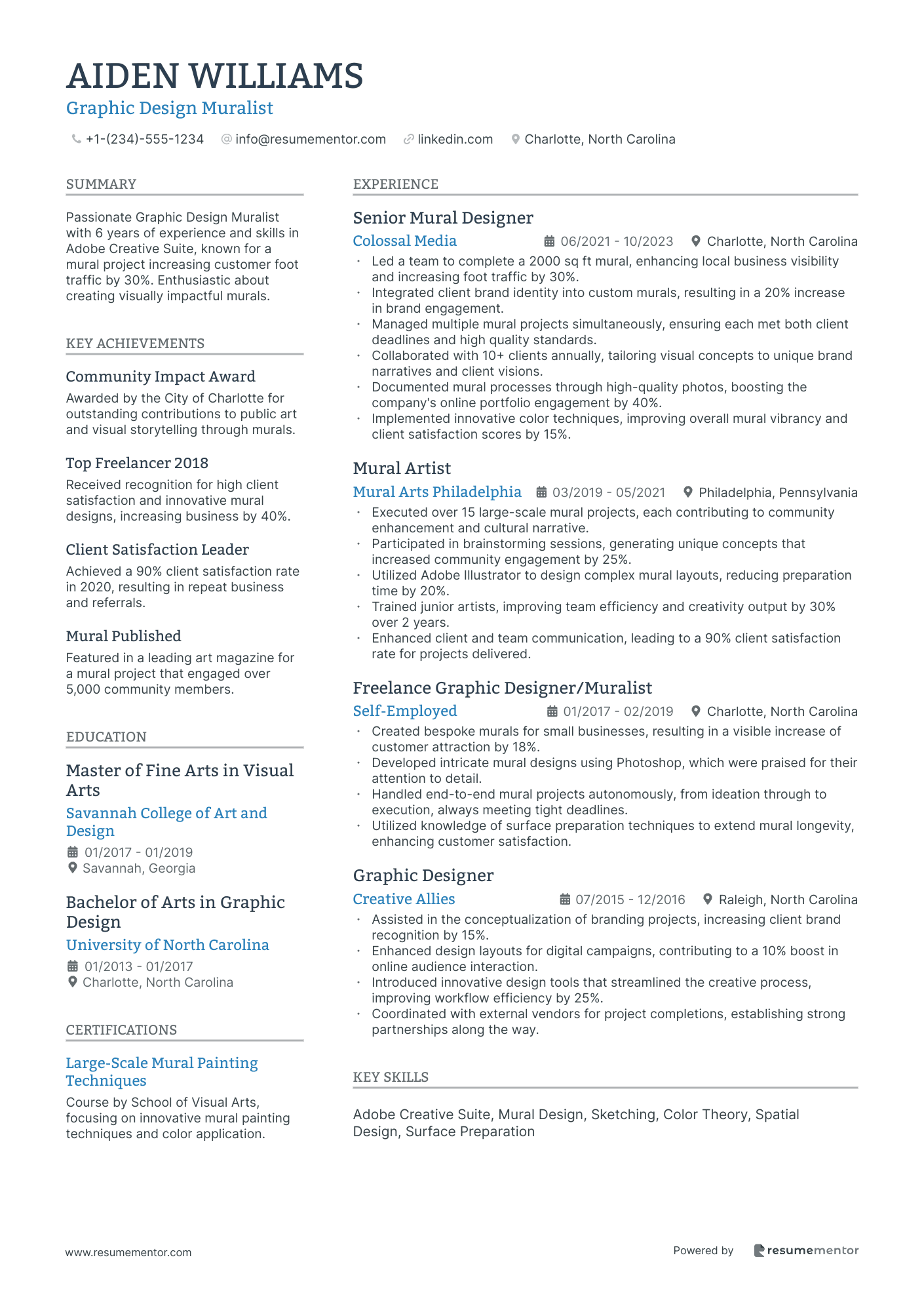
Graphic Design Muralist
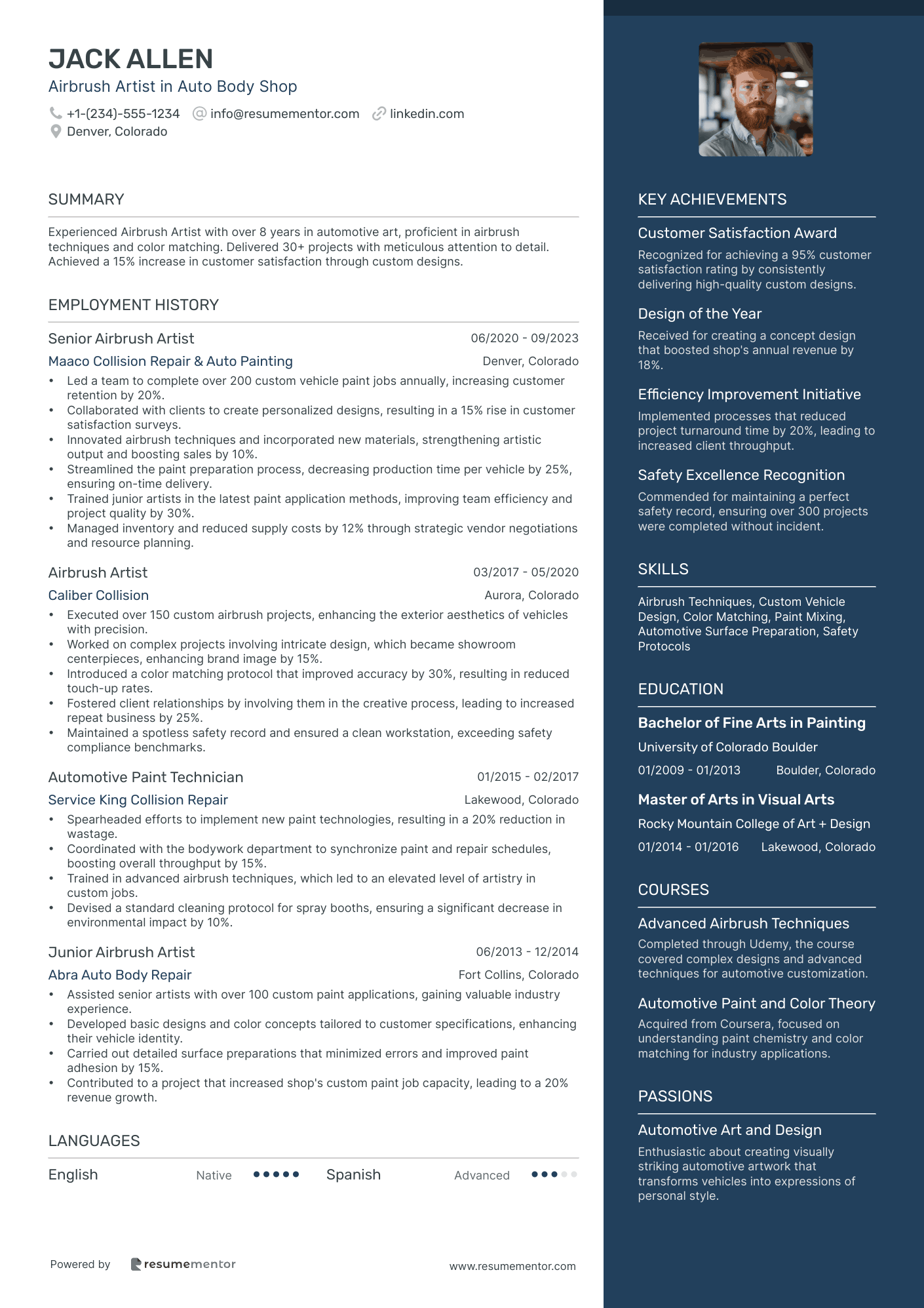
Airbrush Artist in Auto Body Shop
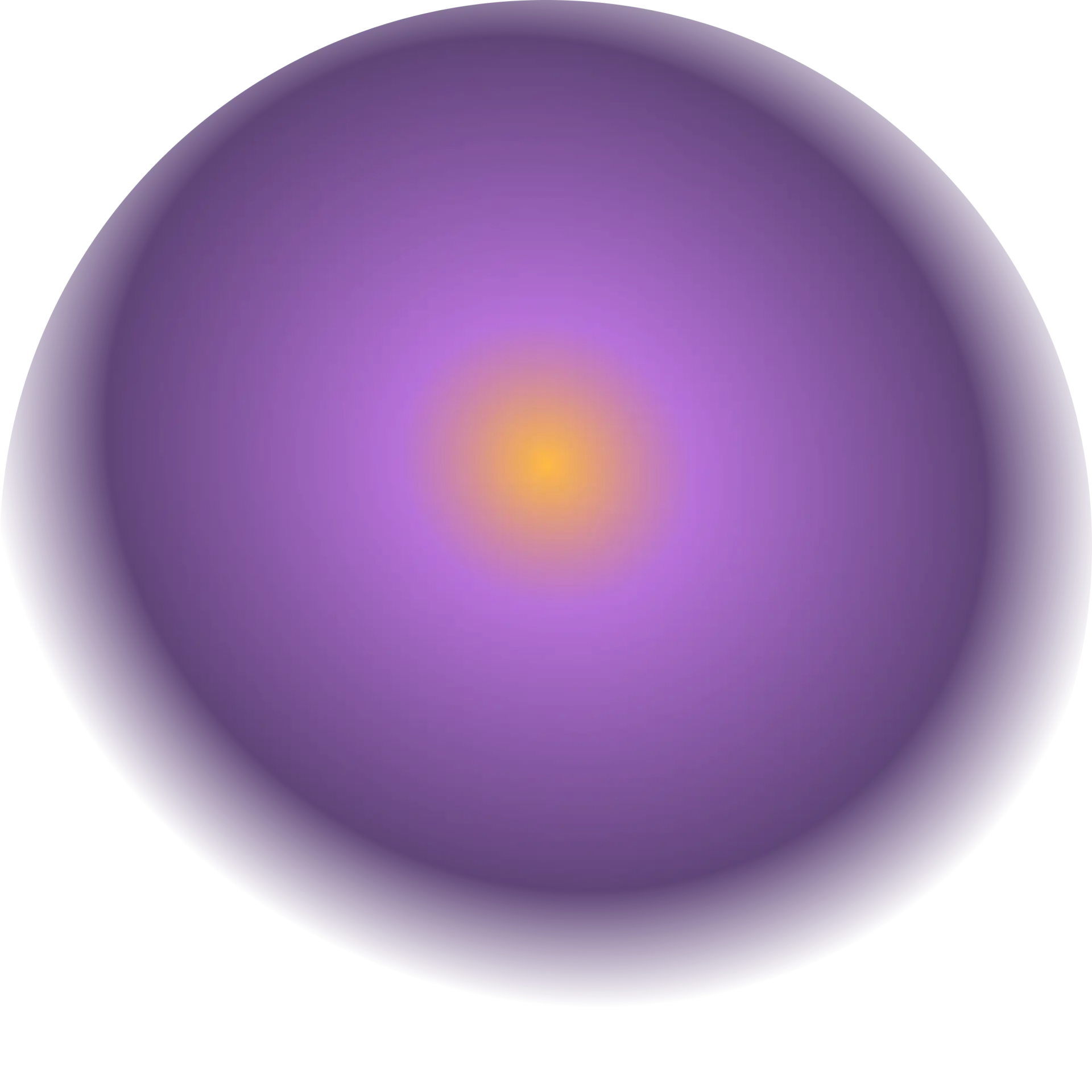
Commercial Building Painter resume sample
- •Led a team to complete a 100,000 sq. ft office building renovation, resulting in a 95% customer satisfaction rate.
- •Implemented a new safety protocol that decreased on-site accidents by 15%, showcasing leadership in safety compliance.
- •Managed a team of 5 painters to on-time delivery of a $500,000 project, ensuring quality control and excellence.
- •Trained junior painters on innovative painting techniques, improving team performance and project outcomes substantially.
- •Ensured all tools were maintained, reducing downtime due to equipment issues by 30%, highlighting resource management skills.
- •Oversaw surface preparation for an expansive hotel project, achieving a flawless finish that increased client referrals by 25%.
- •Executed painting projects for 20+ commercial properties annually, elevating client feedback ratings by 15%.
- •Led sustainability initiatives by using eco-friendly materials, reducing company overhead costs by 12%.
- •Collaborated with project managers to ensure all jobs were completed within budget, improving financial efficiency by 18%.
- •Developed expertise in spray gun techniques, cutting application time by 25% while maintaining quality standards.
- •Managed a commercial painting project valued at $250,000, completing ahead of the deadline and under budget.
- •Spearheaded the use of new paint technology, resulting in a 50% reduction in repaint requests from clients.
- •Crafted comprehensive estimates for potential projects, increasing closure rate of new deals by 20%.
- •Exhibited strong attention to detail by meticulously preparing surfaces, achieving uniform paint finishes across multiple projects.
- •Used professional-grade tools to apply finishes on high-profile buildings, meeting and exceeding project quality standards.
- •Handled surface preparation and painting for diverse commercial properties, contributing to 100% on-time project completion.
- •Improved operational efficiency by organizing tools, resulting in a 10% reduction in preparation time.
- •Enhanced communication with clients, garnering a 30% increase in positive feedback for customer interactions.
- •Adopted industry innovations that doubled application speed without compromising on detail or finesse.
Automotive Spray Painter resume sample
- •Enhanced paint application efficiency by 30% through optimized equipment usage, leading to increased throughput and reduced waste.
- •Achieved 95% customer satisfaction rate by implementing meticulous quality control measures in the painting processes.
- •Trained and mentored a team of four junior painters, resulting in a 20% decrease in customer complaints regarding paint inconsistencies.
- •Collaborated with suppliers to source environmentally-friendly paints, reducing VOC emissions by 40% in compliance with regulations.
- •Implemented a digital color matching system, elevating accuracy by 15% and ensuring consistent results across projects.
- •Led a team that reduced project turnaround time by 25%, contributing to improved client retention and project profitability.
- •Oversaw the completion of over 500 vehicle paint jobs annually, ensuring compliance with company quality standards.
- •Innovation in mixing techniques reduced material costs by 15% while maintaining finish quality, resulting in higher profitability.
- •Collaborated with a cross-functional team to develop a new masking process that decreased preparation time by 18%.
- •Participated in a project updating facility technologies, enhancing the paint department's capabilities to handle larger volumes.
- •Successfully maintained a clean and organized workspace, resulting in zero safety incidents during tenure.
- •Used advanced spray gun techniques to achieve a 98% first-pass quality rate, minimizing rework and resource usage significantly.
- •Orchestrated weekly team meetings to discuss process improvements, leading to a 10% increase in department efficiency.
- •Implemented a color experimentation initiative that expanded paint color offerings by 12%, increasing customer options.
- •Developed a comprehensive training guide for new hires, standardizing procedures and improving skill acquisition timelines.
- •Conducted over 300 vehicle paint jobs per year while maintaining high standards of quality, ensuring consistency across projects.
- •Led a workshop on industry trends, providing insights into modern techniques and resulting in upgraded team skills.
- •Streamlined paint mixing processes leading to a cost reduction of 12% without compromising finish standards.
- •Participated in monthly department audits, maintaining compliance with safety and cleanliness standards to uphold company policies.
Residential Interior Decorator resume sample
- •Implemented cutting-edge design concepts that increased client satisfaction scores by 40%, resulting in increased referrals.
- •Led a team of decorators to completion of a $2 million project on time and under budget by 15%.
- •Collaborated with high-end furniture vendors, improving the selection process and reducing delivery times by 25%.
- •Developed innovative mood boards, drastically enhancing project presentation quality, leading to a 50% boost in client approvals.
- •Coordinated with contractors to achieve a zero-defect rate in 95% of completed installations, improving client trust.
- •Managed the redesign of a historic home, preserving architectural integrity and enhancing resale value by 30%.
- •Spearheaded a design team to transform urban lofts into stylish living spaces, increasing occupancy rates by 20%.
- •Introduced eco-friendly materials, minimizing it's carbon footprint and reducing costs by 12%, attracting environmentally-conscious clients.
- •Revamped a client's mansion's interior, resulting in awards recognition and a 40% increase in company press mentions.
- •Led product sourcing for a large-scale renovation, achieving a 30% savings on materials by negotiating with new vendors.
- •Composed detailed design proposals for clients, elevating project pitch success rates by 45% from previous years.
- •Assisted in designing an award-winning model home that increased visitor traffic by 35%.
- •Created layouts and mood boards for diverse projects, successfully aligning with client expectations 90% of the time.
- •Developed a social media strategy showcasing projects, expanding online client engagement by 50% within six months.
- •Attended design trend seminars that contributed to implementing modern design elements, enhancing client offerings.
- •Assisted in sourcing materials and accessories, ensuring projects adhered to budget constraints and standards.
- •Supported senior decorators with renderings and presentations, contributing to a 25% increase in client approval rates.
- •Managed inventory for decor items, optimizing usage by reducing waste and costs by 10%.
- •Conducted site visits, contributing to over 15 successful residential projects by providing detailed spatial analysis.
Fine Arts Painter resume sample
- •Created over 100 original paintings, elevating gallery sales by 30% compared to the previous year.
- •Led a team of 5 artists to develop new art collections for seasonal exhibitions, resulting in increased foot traffic by 20%.
- •Innovated with mixed media techniques to expand creative offerings, achieving recognition in multiple art shows.
- •Collated a comprehensive professional portfolio, effectively managing time and meeting all submission deadlines.
- •Maintained collaboration with curators, ensuring the integration of artist vision aligned with gallery themes.
- •Streamlined workspace organization, aligning with safety guidelines and maximizing production efficiency.
- •Executed custom artwork commissions, leading to a 15% increase in repeat client requests.
- •Curated and participated in over 12 local and national art shows, expanding client base and networking.
- •Utilized watercolor techniques for specialized projects, enhancing diversity in the artist portfolio.
- •Managed the marketing and sales of artwork, improving revenue generation by launching an online store.
- •Implemented time management strategies, consistently meeting all project deadlines without compromising quality.
- •Developed advanced painting workshops, increasing participant enrollments by 40% over two years.
- •Mentored emerging artists in modern techniques, fostering a collaborative and innovative learning environment.
- •Organized community art exhibitions, promoting local talent and enhancing program visibility.
- •Contributed to curriculum development, incorporating digital art tools and software for comprehensive education.
- •Assisted in organizing and installing artwork for exhibitions, ensuring adherence to safety and artistic standards.
- •Facilitated artist and curator relations, improving event coordination efficiency by 25%.
- •Maintained and updated the gallery inventory, contributing to a 15% reduction in catalog errors.
- •Supported marketing efforts, enhancing social media presence and increasing exhibit attendance.
Marine Vessel Painter resume sample
- •Led a team in the preparation and coating of over 50 marine vessels annually, achieving a 95% customer satisfaction rate.
- •Implemented a new surface preparation protocol that reduced preparation time by 20%, increasing overall project efficiency.
- •Coordinated the application of advanced marine coatings, extending the durability of vessel surfaces by up to 30%.
- •Ensured compliance with safety standards, resulting in a zero-incident work environment over two consecutive years.
- •Streamlined equipment maintenance procedures, decreasing downtime by 15% and maintaining operational efficiency.
- •Conducted final quality inspections, ensuring all projects met strict industry specifications and exceeding client expectations.
- •Executed precise staining and varnishing techniques on high-value yacht interiors, enhancing overall aesthetic appeal.
- •Collaborated with a multidisciplinary team to complete projects ahead of schedule, saving approximately 10% in labor costs.
- •Developed proficiency in spray equipment operations, increasing application speed by 25% through improved methodology.
- •Conducted regular inspections and maintenance of painting gear, resulting in prolonged equipment lifespan and reliability.
- •Trained junior painters on safety and coating techniques, fostering a skilled and knowledgeable team environment.
- •Prepared and primed large-scale vessel sections, ensuring seamless application of waterproof coatings.
- •Optimized paint usage and minimized waste, implementing eco-friendly practices that reduced excess materials by 10%.
- •Performed detailed inspections post-painting, resulting in a 5% reduction in follow-up repairs and touch-ups.
- •Installed protective layers on critical equipment, safeguarding operational components against corrosive marine environments.
- •Assisted in the surface preparation of various decks and bulkheads, gaining foundational skills in extreme attention to detail.
- •Learned intricate brush and roller techniques, applying finishes across diverse vessel surfaces with precision.
- •Developed an understanding of safety regulations in marine environments, leading to zero accidents during tenure.
- •Contributed to the efficient use of resources, maintaining cost-effective practices and high-quality standards.
Historic Preservation Painter resume sample
- •Led a team to restore a 200-year-old building façade, ensuring historical accuracy and achieving a 95% client satisfaction rate.
- •Developed custom paints and stains to match historical color palettes, boosting project success rate by 20% over previous year.
- •Trained 15 new employees on traditional painting techniques, resulting in a 50% improvement in onboarding efficiency.
- •Collaborated with top conservationists to preserve the original aesthetics of historic properties under tight project timelines.
- •Conducted inspections of 50+ projects, identifying areas needing restoration and implementing corrective measures promptly.
- •Implemented safety protocols, reducing on-site accidents by 30% through comprehensive training and vigilance.
- •Spearheaded restoration of historic theatre interiors, utilizing period-specific materials to enhance project authenticity.
- •Executed complex paint matching for multiple projects, increasing client retention by 15% annually.
- •Collaborated with architects to integrate modern and traditional techniques, optimizing restoration processes.
- •Produced detailed project documentation, detailing materials and procedures, with 100% compliance on preservation audits.
- •Optimized team workflows, reducing project completion times by 10% without compromising on quality.
- •Managed preservation projects for historic residential buildings, achieving a 40% increase in area home valuations.
- •Trained cross-functional teams in sustainable practices, enhancing team expertise and ensuring best preservation standards.
- •Led color and finish selection projects for 15+ historic homes, enhancing community engagement and appreciation.
- •Improved quality control measures, achieving a 99% success rate in project completion as per specifications.
- •Supervised a team of 10 painters in completing a high-profile city contract, improving public space aesthetics by 30%.
- •Administered paint supply inventories, reducing costs by 15% while maintaining quality.
- •Ensured compliance with safety standards across all projects, achieving a zero-incident rate.
- •Enhanced customer satisfaction scores by 25% through meticulous attention to detailed finishing touches.
Industrial Coatings Specialist resume sample
- •Led a team to optimize industrial coatings applications, improving process efficiency by 20% and reducing material waste by 15%.
- •Expanded client base by 30% through technical consultations, increasing revenue by $500,000 annually.
- •Developed a new surface preparation technique that decreased preparation time by 18% while maintaining compliance.
- •Implemented training programs that enhanced team skills and increased productivity by 25%.
- •Executed quality control measures resulting in a 99% project success rate and decreased rework costs by 40%.
- •Collaborated with R&D to introduce high-performance polyurethane coatings, achieving a 12% increase in product lifespan.
- •Refined application methods, increasing coating coverage by 15% and reducing application time by 10%.
- •Introduced an innovative client feedback system, leading to a 30% improvement in customer satisfaction metrics.
- •Conducted quality assurance audits, achieving 96% compliance with industry standards.
- •Championed sustainability initiatives that reduced VOC emissions by 25%, aligning with environmental standards.
- •Streamlined maintenance procedures that cut downtime by 20% and improved operational continuity.
- •Performed accurate surface preparation that led to a 98% first-pass yield rate on high-stakes projects.
- •Received Technician of the Year award for maintaining a 95% client satisfaction rate over three years.
- •Facilitated cross-functional teamwork which reduced project delays by 25% and ensured timely completion.
- •Participated in development of a proprietary coating formula, resulting in improved durability and market competitiveness.
- •Coordinated projects leading to a 10% improvement in application consistency and client approval ratings.
- •Executed surface assessments, raising procedure accuracy by 20% and adherence to specifications.
- •Reduced labor costs by 15% through efficient allocation of resources during peak project phases.
- •Implemented safety protocols that resulted in a 30% decrease in workplace incidents.
Faux Finish Artist resume sample
- •Led a team of 5 artists on a luxury hotel project, delivering exceptional decorative finishes that enhanced aesthetics, resulting in a 25% client referral increase.
- •Collaborated with designers to develop custom venetian plaster finishes, increasing project approval rates by 30% in one year.
- •Implemented new faux finishing techniques that reduced project time by 15% while maintaining quality, positively impacting client satisfaction scores.
- •Regularly updated and maintained equipment, reducing downtime by 20% through effective tool management and training initiatives.
- •Revamped color theory training programs, resulting in a 40% improvement in staff proficiency in creating custom blends.
- •Managed safety protocols on-site, maintaining a 100% accident-free record across all projects and installations.
- •Executed decorative finishes on over 100 residential and commercial properties, increasing sales by 20% year-over-year through client recommendations.
- •Specialized in rag rolling techniques, implementing innovative solutions for complex surfaces, achieving a 95% client satisfaction rate.
- •Conducted client consultations to identify design goals, increasing project quote acceptance by 10% through effective communication.
- •Created seamless faux finishes that seamlessly integrated with client decor, contributing to a 15% growth in repeat business.
- •Developed a comprehensive library of faux finishes, improving team efficiency and client service quality by 25% through digital resource utilization.
- •Implemented sponging techniques in high-end properties, leading to recognition in a local design magazine and boosting company profile by 30%.
- •Adapted quickly to client demands, completing projects 20% faster than industry average without compromising aesthetic quality.
- •Trained junior artists on techniques and safety, reducing errors by 50% and improving team’s overall craftsmanship.
- •Assisted in project management, ensuring timely project completion and improving efficiency by 15% through effective scheduling.
- •Applied stippling techniques for over 50 commercial clients, increasing decorative service demand by 20% within two years.
- •Successfully collaborated with varying clientele to deliver personalized finishing touches, enhancing client retention rates significantly.
- •Maintained impeccable workspaces, promoting organization and safety, leading to zero recordable incidents over two years.
- •Proactively researched and integrated new materials into projects, improving project quality and client feedback scores by 10%.
Graphic Design Muralist resume sample
- •Led a team to complete a 2000 sq ft mural, enhancing local business visibility and increasing foot traffic by 30%.
- •Integrated client brand identity into custom murals, resulting in a 20% increase in brand engagement.
- •Managed multiple mural projects simultaneously, ensuring each met both client deadlines and high quality standards.
- •Collaborated with 10+ clients annually, tailoring visual concepts to unique brand narratives and client visions.
- •Documented mural processes through high-quality photos, boosting the company's online portfolio engagement by 40%.
- •Implemented innovative color techniques, improving overall mural vibrancy and client satisfaction scores by 15%.
- •Executed over 15 large-scale mural projects, each contributing to community enhancement and cultural narrative.
- •Participated in brainstorming sessions, generating unique concepts that increased community engagement by 25%.
- •Utilized Adobe Illustrator to design complex mural layouts, reducing preparation time by 20%.
- •Trained junior artists, improving team efficiency and creativity output by 30% over 2 years.
- •Enhanced client and team communication, leading to a 90% client satisfaction rate for projects delivered.
- •Created bespoke murals for small businesses, resulting in a visible increase of customer attraction by 18%.
- •Developed intricate mural designs using Photoshop, which were praised for their attention to detail.
- •Handled end-to-end mural projects autonomously, from ideation through to execution, always meeting tight deadlines.
- •Utilized knowledge of surface preparation techniques to extend mural longevity, enhancing customer satisfaction.
- •Assisted in the conceptualization of branding projects, increasing client brand recognition by 15%.
- •Enhanced design layouts for digital campaigns, contributing to a 10% boost in online audience interaction.
- •Introduced innovative design tools that streamlined the creative process, improving workflow efficiency by 25%.
- •Coordinated with external vendors for project completions, establishing strong partnerships along the way.
Airbrush Artist in Auto Body Shop resume sample
- •Led a team to complete over 200 custom vehicle paint jobs annually, increasing customer retention by 20%.
- •Collaborated with clients to create personalized designs, resulting in a 15% rise in customer satisfaction surveys.
- •Innovated airbrush techniques and incorporated new materials, strengthening artistic output and boosting sales by 10%.
- •Streamlined the paint preparation process, decreasing production time per vehicle by 25%, ensuring on-time delivery.
- •Trained junior artists in the latest paint application methods, improving team efficiency and project quality by 30%.
- •Managed inventory and reduced supply costs by 12% through strategic vendor negotiations and resource planning.
- •Executed over 150 custom airbrush projects, enhancing the exterior aesthetics of vehicles with precision.
- •Worked on complex projects involving intricate design, which became showroom centerpieces, enhancing brand image by 15%.
- •Introduced a color matching protocol that improved accuracy by 30%, resulting in reduced touch-up rates.
- •Fostered client relationships by involving them in the creative process, leading to increased repeat business by 25%.
- •Maintained a spotless safety record and ensured a clean workstation, exceeding safety compliance benchmarks.
- •Spearheaded efforts to implement new paint technologies, resulting in a 20% reduction in wastage.
- •Coordinated with the bodywork department to synchronize paint and repair schedules, boosting overall throughput by 15%.
- •Trained in advanced airbrush techniques, which led to an elevated level of artistry in custom jobs.
- •Devised a standard cleaning protocol for spray booths, ensuring a significant decrease in environmental impact by 10%.
- •Assisted senior artists with over 100 custom paint applications, gaining valuable industry experience.
- •Developed basic designs and color concepts tailored to customer specifications, enhancing their vehicle identity.
- •Carried out detailed surface preparations that minimized errors and improved paint adhesion by 15%.
- •Contributed to a project that increased shop's custom paint job capacity, leading to a 20% revenue growth.
As a professional painter, your canvas is the world, bringing scenes to life with every stroke. Yet, when crafting your resume, you might find it feels like staring at an empty canvas, unsure of where to begin. Your artistic eye and hands-on experience are unmatched, but translating them into words can be challenging. Employers want to see your artistic achievements and technical expertise laid out clearly on the page—but how do you arrange it all seamlessly?
Painting a vivid picture of your career requires the right words and format. A well-crafted resume does more than list jobs; it's your opportunity to leave a memorable impression. Just as your art reflects your attention to detail through vibrant colors and precise lines, your resume should capture that same essence. This is where a resume template becomes invaluable, offering a structured starting point that allows your unique skills and experiences to shine through. These resume templates can provide the framework you need, making the writing process smoother.
A thoughtfully chosen format ensures your talents are highlighted and catch the eye of potential employers. While your brushstrokes define your art on canvas, your resume’s structure crafts the foundation of your professional journey. Think of it as the initial layer of paint, setting the tone for everything that follows. With the right approach, writing a resume can become as natural as creating a masterpiece. Let’s dive into crafting a resume that truly embodies your artistry.
Key Takeaways
- A professional painter's resume should clearly highlight skills, experience, and dependability, emphasizing artistic achievements, technical expertise, and project accomplishments.
- Using a reverse chronological format with modern fonts and saving the resume as a PDF ensures an attractive and professional presentation that maintains visual integrity.
- Quantifiable achievements in the experience section, such as improved client satisfaction or reduced project timelines, demonstrate value to potential employers.
- Effective use of the skills section, including both hard and soft skills, helps employers quickly recognize the candidate's capabilities and fit for the job.
- Including certifications and additional sections like language skills or volunteer work can enrich the resume, highlighting personal qualities and setting the candidate apart.
What to focus on when writing your professional painter resume
A professional painter's resume should effectively communicate your skills, experience, and dependability to the recruiter—this means bringing attention to your ability to deliver high-quality work, meet deadlines, and collaborate with others. Demonstrating your expertise in various painting techniques and tools is crucial, along with showing your dedication to safety and cleanliness on the job.
How to structure your professional painter resume
- Contact Information: Start with your contact details, ensuring accuracy for immediate communication. A polished LinkedIn profile can showcase your professional network and serve as an extended resume. It's the first step to a good impression, so clarity is key.
- Professional Summary: Offer a snapshot of your painting career, highlighting areas like residential, commercial, or industrial painting. Mention unique skills or techniques you've mastered, like decorative painting or faux finishes, to create a compelling picture of your professional identity.
- Work Experience: Detail your previous positions in reverse chronological order. Include job titles, companies, and locations, as well as the tenure of your employment. Use bullet points to focus on your responsibilities and accomplishments, drawing attention to your reliability and project completion rate.
- Skills: Highlight specific abilities such as proficiency with sprayers, rollers, and brushes, and your understanding of color theory. Mention safety certifications and your experience in surface preparation and repair to provide a complete view of your qualifications.
- Education and Training: Include your educational background, starting with your high school diploma or GED. If you've attended trade schools or taken specialized courses, mention these along with institution names and graduation dates—these underscore your commitment to the craft.
- Certifications and Licenses: Point out any professional certifications or licenses, such as a lead-safe certification or state painting license. Such credentials distinguish you from other candidates and affirm your expertise.
As we delve into each section more in-depth below, you'll learn how to format your resume most effectively, ensuring each detail supports your candidacy as a professional painter.
Which resume format to choose
Creating a standout painter resume requires a thoughtful approach to format, style, and presentation. For professional painters, using a reverse chronological format is particularly effective. This structure highlights your most recent and relevant projects, allowing potential employers to quickly understand the scope of your current skills and expertise.
Incorporating modern fonts like Rubik, Montserrat, or Raleway can enhance your resume's aesthetic appeal. These fonts offer a clean and contemporary look that aligns with the creative nature of the painting profession. While readability is key, these fonts also help your resume stand out with a subtle touch of style that speaks to your artistic sensibility.
Saving your resume as a PDF is crucial in maintaining the intended design and layout. PDFs ensure that your document looks the same on any device, which is important for preserving the visual presentation that you've worked hard to create. It's a professional format that hiring managers expect and appreciate.
Attention to detail in your resume's layout, such as maintaining one-inch margins, enhances readability and organization. Clean margins prevent your text from feeling crammed, offering a polished look that reflects your meticulousness and professionalism.
By focusing on these key elements, you craft a resume that not only showcases your talents but also leaves a lasting impression, capturing the interest of those seeking a skilled and creative painter.
How to write a quantifiable resume experience section
Creating a strong experience section for your resume as a professional painter means showcasing how your skills and accomplishments have made a difference in past projects. This section is where you communicate your value to potential employers and should focus on your ability to adapt to various challenges. Start by listing your most recent position and go back about 10 to 15 years, including clear job titles like "Lead Painter" or "Commercial Painter" to highlight your level of expertise. Tailor each entry to the job ad by integrating relevant keywords, ensuring you spotlight experiences and skills that align with what the employer is looking for. Use active words like "coordinated," "led," "improved," and "managed" to convey your accomplishments effectively.
- •Developed a streamlined process that reduced project timelines by 15%, enhancing overall productivity.
- •Led a team of 10 painters, achieving a 98% client satisfaction rate by delivering high-quality results.
- •Introduced new safety protocols, successfully cutting workplace incidents by 20%, ensuring a safer environment.
- •Managed projects with budgets up to $500,000, consistently staying under budget and maximizing resources.
This example stands out because it seamlessly connects your achievements with the skills valued in the painting industry. By detailing how you reduced project timelines and boosted client satisfaction, you’re highlighting not only your technical skills but also your leadership and efficiency. Introducing new safety protocols and effectively managing large budgets shows your commitment to safety and financial responsibility. This interconnected approach ensures that potential employers can quickly understand the full scope of your capabilities and the positive impact you can have on their team.
Result-Focused resume experience section
A result-focused professional painter resume experience section should clearly demonstrate how your skills and achievements have made a significant impact in your previous roles. Highlight the key responsibilities where you excelled, emphasizing the unique methods you used to achieve superior results. Connecting these aspects with clear accomplishments is crucial, especially those that can be quantified, like enhancing client satisfaction, boosting efficiency, or improving quality.
Begin by listing your job title, the time you spent in the role, and where you worked, followed by bullet points that detail your key contributions. Start each point with a strong action verb and ensure it conveys how you enhanced the project or team. Whether you sped up project timelines, received recognition for your precision, or innovated with new painting techniques, these stories will illustrate your value as a candidate, creating a cohesive narrative of your professional journey.
Professional Painter
Quality Paint Works
June 2019 - March 2023
- Completed over 50 residential projects each year, consistently achieving a 95% customer satisfaction rate.
- Led and motivated a team to boost project efficiency by 20%, meeting tight deadlines without sacrificing quality.
- Pioneered a new color matching technique that increased paint job precision by 30%, gaining client trust.
- Awarded 'Contractor of the Year' in 2021 for outstanding attention to detail and project excellence.
Innovation-Focused resume experience section
An innovation-focused painter's resume experience section should highlight how you've creatively contributed to your work and improved outcomes. Start by mentioning experiences where you introduced imaginative solutions, unique techniques, or distinct styles that set your projects apart. It's important to connect these with achievements that show how your inventive approaches led to better efficiency, impressive results, or increased client satisfaction. Use action verbs to clearly articulate your contributions and the positive impacts they had.
To make your descriptions compelling, discuss the specific techniques or tools that made your work stand out, and how they contributed to your success. Seamlessly integrate details about any collaborative efforts with clients or team members that led to innovative results. This cohesive narrative showcases your ability to generate creative ideas and effectively implement them, whether independently or with a team.
Lead Painter
ColorBurst Innovations
June 2020 - Present
- Developed a unique mural painting technique that increased work efficiency by 30%.
- Introduced an eco-friendly paint option that attracted 15% more eco-conscious clients.
- Collaborated with a team of artists to design an award-winning community mural.
- Implemented a new digital design process that shortened project planning time by 20%.
Customer-Focused resume experience section
A customer-focused painter resume experience section should clearly demonstrate your ability to meet clients’ needs while showcasing your successes in past projects. Start by identifying the section's focus, such as "Customer-Focused Painting Projects." Use specific examples to highlight how you listened to clients, offered creative solutions, and delivered top-notch results. Using simple, clear language will help your expertise shine through.
In each bullet point, include relevant details like timeframes, tools, techniques, and positive client feedback. These elements should flow logically to showcase distinct strengths, like your technical skills, communication abilities, or knack for solving problems. By providing real-world examples, you help potential employers visualize your contributions to their team. Keep your points concise but impactful, focusing on your ability to exceed customer expectations and resonate with potential employers.
Lead Painter
Bright Spaces Painting Co.
March 2020 – Present
- Collaborated with over 50 homeowners to understand and execute their vision, earning a 95% satisfaction rate.
- Used eco-friendly paints and innovative techniques, achieving 100% waste reduction and high-quality finishes.
- Led a team of three junior painters, boosting project efficiency by 30% through effective delegation and mentoring.
- Resolved color discrepancies quickly, enhancing client trust and rapport, which led to frequent referrals.
Training and Development Focused resume experience section
A training-focused professional painter resume experience section should highlight experiences where you not only honed your skills but also helped others develop theirs. Start by mentioning any formal education, apprenticeships, or courses you completed, showcasing how these shaped your abilities. Next, describe how you used these skills in your work, clearly stating your job title and highlighting responsibilities that emphasized training or skill development. This creates a narrative of continuous growth and learning.
In the bullet points, focus on tangible results or examples of skill application. For instance, think about instances where you mentored junior painters and helped them improve. Perhaps you developed a new technique that boosted efficiency. Use active, specific language to illustrate your contributions and development. This approach demonstrates your capacity for learning and adapting while also helping others to grow in their roles.
Senior Painter
Color Artisans, Inc.
June 2019 - Present
- Participated in a two-month workshop on advanced painting techniques, improving surface finish by 30%.
- Mentored 5 apprentice painters, leading to a 50% improvement in their skill assessment scores.
- Developed a new method for color blending that reduced paint usage costs by 10%.
- Collaborated with a team to create a training manual, enhancing team productivity by 25%.
Write your professional painter resume summary section
A painter-focused resume summary should highlight your creativity and expertise in a compelling way. Think of a summary as your personal pitch, crafted to quickly convey your unique painting techniques and impressive projects. If you have years of experience, a resume summary is key. You should provide tangible examples of your work, like high-profile projects or awards. For instance:
This example begins by stating your extensive experience, immediately building trust with employers. Mentioning your expertise in both traditional and modern skills demonstrates your versatility. Furthermore, highlighting client praise and repeat business underscores reliability and success.
If you're newer to the field, focus on what makes you unique in a resume objective. Having a unique style or training under a renowned painter can make you stand out. Emphasize key skills and ambitions, such as:
[here was the JSON object 2]
This objective captures your eagerness and fresh skills, appealing to potential employers. While a summary focuses on who you are and your accomplishments, an objective zeroes in on your aspirations and goals. Both are similar to a resume profile, which includes achievements and future aims. A summary of qualifications serves as a checklist of skills and accomplishments, ideal for technical roles. Whichever section you choose, ensure your words craft a vivid picture of you as an accomplished painter.
Listing your professional painter skills on your resume
A skills-focused professional painter resume should effectively display your abilities and expertise. Start by deciding if you'd like to list your skills separately or weave them into sections like your experience or summary. While strengths and soft skills reflect how well you engage with others, hard skills are your specific abilities gained through education and practice. Highlighting these aspects prominently on your resume can make you stand out to both potential employers and their hiring systems. Consider using a format that clearly outlines your competencies, like this:
A standalone skills section is valuable because it allows hiring managers to instantly recognize what you bring to the table. By featuring skills relevant to professional painting, you signal that you're well-prepared for the role.
Best hard skills to feature on your professional painter resume
For a professional painter, hard skills are where your technical expertise shines. These skills reassure employers of your capacity to deliver high-quality results.
Hard Skills
- Surface Preparation
- Color Matching
- Spray Painting
- Wallpapering
- Detailed Brushwork
- Stain Application
- Mixing Paints
- Finish and Texture
- Pressure Washing
- Safety Procedures
- Masking and Taping
- Roller Techniques
- Airless Spray Techniques
- Decorative Finishes
- Drywall Repair
Best soft skills to feature on your professional painter resume
Equally important are your soft skills. They demonstrate your ability to work effectively with others and adapt to different settings, showcasing your professionalism and commitment to excellent service.
Soft Skills
- Attention to Detail
- Time Management
- Communication
- Problem Solving
- Reliability
- Patience
- Adaptability
- Teamwork
- Commitment to Quality
- Customer Service
- Creativity
- Flexibility
- Interpersonal Skills
- Stress Management
- Organization
How to include your education on your resume
An education section is a key part of your resume, especially if you're aiming to become a professional painter. It provides proof of your knowledge and skills. Always tailor this section to the job you’re applying for. If your education doesn't relate to painting, it's best left out. Including your GPA is a good idea if it's high, typically 3.5 or above. You can write it like "GPA: 3.8/4.0" under your degree. Achievements like graduating cum laude should also be noted to show excellence. When listing a degree, use the official title, such as "Bachelor of Fine Arts in Painting." Here's the wrong and right way to do it:
This corrected example is ideal. It highlights a relevant degree, showing you are well-trained in painting. Including the GPA of 3.9 underscores academic success. Leaving out irrelevant coursework keeps the focus on what's important to the job. Following this guide ensures your resume aligns well with the professional painter role.
How to include professional painter certificates on your resume
When creating a resume, including a certificates section is crucial for showcasing your qualifications as a professional painter. Start by listing the name of each certificate you hold. Include the date you received each one, as well as the organization that issued it. You can also integrate your certificates into your resume header to draw immediate attention. For instance, you might format it as: "Jane Doe, Certified Interior Paint Specialist." This approach highlights your certifications right away, underscoring your expertise.
A strong example of a standalone certificates section might look like this:
This example stands out because it provides precise information relevant to painting. It includes recognized certifications from reputed organizations. Listing these not only verifies your capabilities but also exhibits commitment to proven standards of quality and safety in painting work. Highlighting such achievements can assure potential employers of your proficiencies and attention to industry protocols.
Extra sections to include on your professional painter resume
Crafting a resume as a professional painter involves more than just listing your work experience and skills. Including various sections can showcase your personal qualities and enhance your candidacy. Understanding how to present these areas effectively can make a significant difference in your job application.
- Language section — Highlight your multilingual ability to communicate with diverse clients and understand their needs better.
- Hobbies and interests section — Illustrate your creative pursuits or interests like sketching or art history, emphasizing your passion for artistry beyond your work.
- Volunteer work section — Demonstrate your community involvement and willingness to contribute your painting skills to charitable causes, which highlights your generosity and teamwork abilities.
- Books section — Mention art-related books you have read to reflect your continuous learning and dedication to mastering your craft.
Incorporating these sections effectively can offer a fuller picture of who you are as a professional and an individual, making you stand out from the competition.
In Conclusion
In conclusion, writing a professional painter's resume requires a strategic approach to effectively communicate your unique skills and achievements. By using a structured format, you can ensure that your artistic talents are showcased clearly and compellingly. Focus on incorporating your technical proficiencies, such as understanding color theory and mastering various painting techniques, to underscore your expertise. Highlighting your ability to complete projects on time, maintain safety standards, and collaborate with others will appeal to potential employers. Remember, a thoughtful presentation will leave a lasting impression, just as your artwork does. Using a reverse chronological format is beneficial as it emphasizes your most recent accomplishments and abilities. Additionally, choosing a clean, modern font like Rubik or Montserrat adds a stylish touch that reflects your creative background. Always save your resume as a PDF to maintain the intended design, ensuring it appears seamlessly across all devices. Crafting a resume with attention to detail, similar to a meticulous brushstroke, will help you stand out in the competitive job market. By following these guidelines, you present yourself as a skilled and professional candidate ready to enhance any painting team.
Related Articles
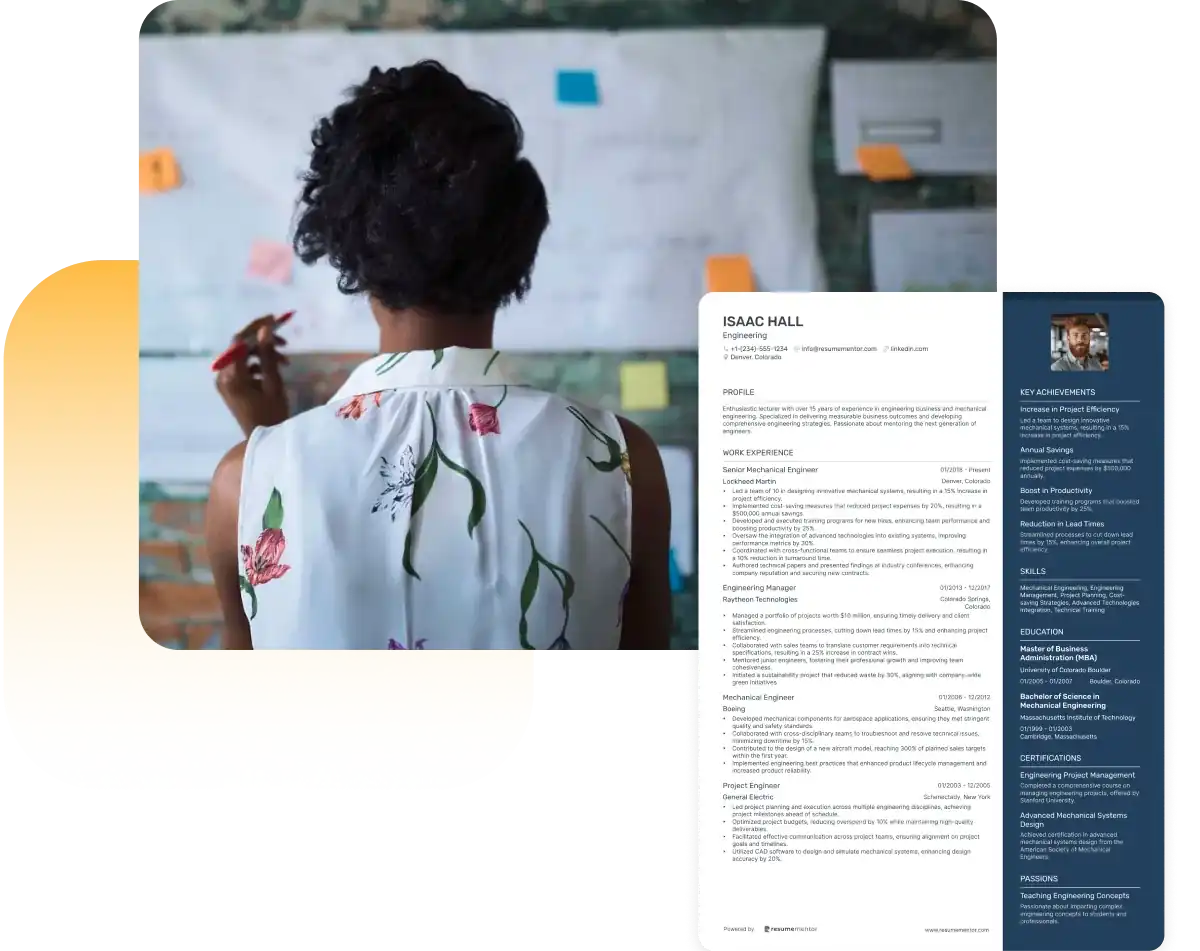
Continue Reading
Check more recommended readings to get the job of your dreams.
Resume
Resources
Tools
© 2025. All rights reserved.
Made with love by people who care.

